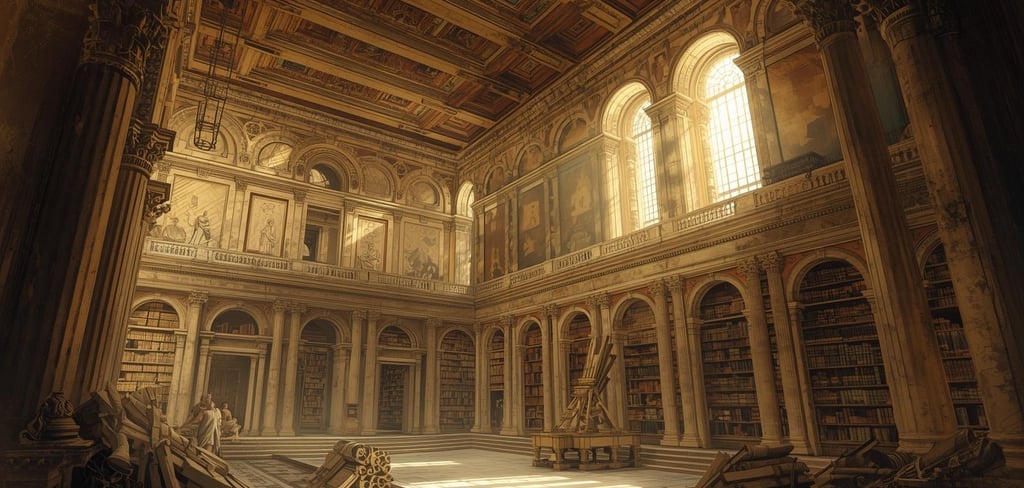
The Library of Alexandria: Myth, Memory, and the Pursuit of Knowledge
Few institutions in human history have captured the imagination as much as the Library of Alexandria. More than just being a repository of texts, it became a symbol of humanity’s hunger for knowledge, its fragility in the face of political upheaval, and the paradoxical way memory persists even when physical artifacts vanish. To write about the Library of Alexandria is to straddle fact and legend, as much of what we “know” is pieced together from scattered references, myth-making, and cultural nostalgia.
9/14/2025



The Library of Alexandria: Myth, Memory, and the Pursuit of Knowledge
Few institutions in human history have captured the imagination as much as the Library of Alexandria. More than just being a repository of texts, it became a symbol of humanity’s hunger for knowledge, its fragility in the face of political upheaval, and the paradoxical way memory persists even when physical artifacts vanish. To write about the Library of Alexandria is to straddle fact and legend, as much of what we “know” is pieced together from scattered references, myth-making, and cultural nostalgia.
Origins and Ambitions
The library was founded in the early 3rd century BCE. Under the rule of the Ptolemies, the Macedonian-Greek dynasty. They governed Egypt after the death of Alexander the Great. It is often credited to Ptolemy II Philadelphus (283–246 BCE), though its foundations may have been laid by his father, Ptolemy I Soter.
The vision was audacious: to gather all the world’s knowledge in one place. Alexandria, a cosmopolitan city and hub of trade at the mouth of the Nile, was the ideal setting. Ships that docked in its harbors were reportedly compelled to surrender any scrolls they carried; copies might be returned, but the originals were kept in the library’s collections. Works in Greek, Egyptian, Mesopotamian, Indian, and possibly even early Buddhist and Hebrew traditions were rumored to have been acquired.
The institution was part of the Mouseion (a shrine to the Muses, patron goddesses of the arts and sciences), making it not only a storehouse but also a center for study, debate, and innovation. Scholars such as Euclid (father of geometry), Eratosthenes (who calculated the Earth’s circumference), and Herophilos (an early anatomist) are said to have worked under its auspices.
Knowledge as Power
The ambition of the Library of Alexandria was not merely intellectual curiosity; it was also political. In the ancient world, knowledge equated to dominance. Mastery of medicine, astronomy, mathematics, agriculture, and navigation translated into military and economic strength. By gathering scrolls from Greece, Mesopotamia, India, and beyond, the Ptolemies sought to make Alexandria the unrivaled intellectual capital of the Mediterranean. The cataloging of texts was harvested to serve the coming ages monumentally. The librarian Callimachus of Cyrene created the Pinakes, a bibliographic system that listed hundreds of thousands of scrolls by subject and author—a precursor to the modern library catalog.
The Mystery of Its Destruction
The tragedy most often associated with the library is its destruction. Yet historians debate when, how, and even if a single catastrophic fire ever occurred. Several episodes stand out:
1. Julius Caesar’s Siege (48 BCE): During the civil war in Alexandria, Caesar set fire to enemy ships. Flames spread to the docks and nearby buildings, possibly engulfing part of the library. Ancient sources differ on whether the main collection was lost or only a warehouse of scrolls by the harbor.
2. Aurelian’s Campaign (3rd century CE): When Emperor Aurelian fought Queen Zenobia of Palmyra, battles in Alexandria may have damaged the library or its successor collections.
3. Theodosius I’s Decrees (391 CE): With the rise of Christianity as the Roman Empire’s state religion, pagan temples were destroyed, including the Serapeum, where some library holdings may have been preserved.
4. The Arab Conquest (642 CE): Later tradition—though now considered apocryphal—claims that Caliph Omar ordered the burning of remaining texts, allegedly remarking that if they agreed with the Qur’an they were redundant, and if they contradicted it they were dangerous. Most modern scholars believe this tale is a legend invented centuries after the event.
Rather than a single inferno, the library’s demise likely resulted from gradual attrition—fires, neglect, shifting political tides, and the fragility of papyrus over the centuries.
What Was Lost
The scale of the loss haunts cultural memory. Estimates suggest the library may have housed between 40,000 and 400,000 scrolls, though these numbers remain speculative.
The works possibly lost include:
Histories of civilizations that left no other trace.
Early maps of the known world.
Texts from India and China were transmitted via trade routes.
Mathematical and astronomical theories were centuries ahead of their rediscovery.
Plays by Greek dramatists that never survived elsewhere.
The idea that the wisdom of entire civilizations vanished overnight remains one of history’s great “what ifs.” What if humanity had inherited the accumulated insights of Babylon, Egypt, Greece, and India, uninterrupted by centuries of silence? Would technological revolutions—like printing, medicine, or space exploration—have come earlier?
Myth Versus Reality
Part of the Library’s power lies in the tension between myth and fact. While much of its grandeur may be exaggerated, the legend reflects deep human longing: the dream of total knowledge, preserved and accessible, versus the reality of fragility, impermanence, and loss. The myth also reflects an anxiety about human folly—our tendency to destroy what we most value. The Library’s story has become shorthand for intellectual hubris and cultural tragedy.
Legacy and Modern Resonance
Even in its absence, the Library of Alexandria continues to inspire. It has become a symbol for modern institutions of knowledge—from the British Library to the Internet Archive. The modern Bibliotheca Alexandrina, inaugurated in 2002 on the Alexandrian waterfront, stands as a tribute to this ancient dream. Designed as a vast sun-disk-shaped structure, millions of books are harvested by the institutions, digital archives, and research centers, a reminder that the pursuit of universal knowledge continues. In the digital age, where information can be replicated endlessly yet is still vulnerable to erasure, the memory of the Library of Alexandria feels newly relevant. It reminds us that knowledge must be preserved not just materially but culturally, through constant renewal, sharing, and safeguarding against apathy and destruction.
Conclusion
The Library of Alexandria remains less a historical certainty than a cultural parable. Whether it housed 40,000 scrolls or 400,000, whether destroyed in one catastrophic fire or eroded over centuries, its image endures as the embodiment of both human ambition and human fragility. It teaches us that while the pursuit of knowledge can unify civilizations and empower societies, it also requires vigilance, protection, and humility. In mourning what was lost, we are also challenged to imagine what can still be built: repositories of wisdom resilient enough to withstand the tempests of time.
